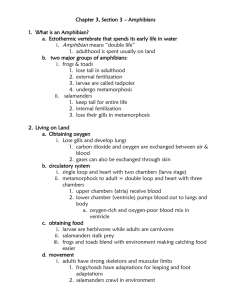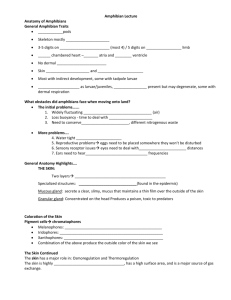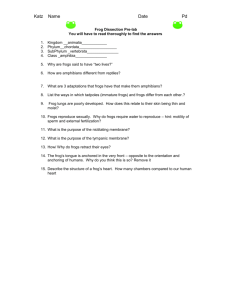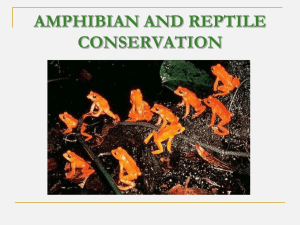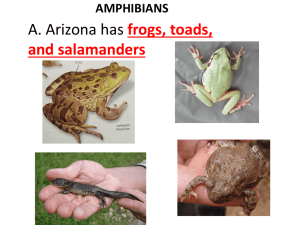Amphibians - Fulton County Schools
advertisement
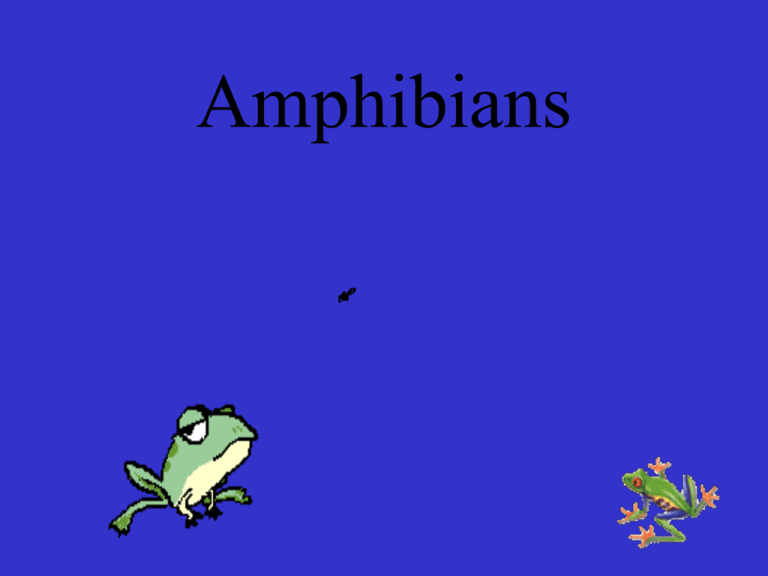
Amphibians Amphibians • AMPHIBIAN=GREEK FOR AMPHIBIOS WHICH MEANS “DOUBLE LIFE” • ECTOTHERMIC VERTEBRATES • HIBERNATE OR ESTIVATE DEPENDING ON CLIMATE Three Orders of Amphibia • • • • Anura-frogs and toads Urodela-salamanders and newts Elongated bodies and tails Young have gills-some adults retain them • Apoda-caecilians • Tropical, burrowing amphibians • Legless, wormlike 4 Characteristics of Amphibians • Legs-important evolution for living on land. caecilians have lost their legs as they adapted to burrowing existence • Lungs-larvae have gills most adults breath with a pair of lungs with the exception of lungless salamanders • Partially divided heart-atrium is divided, but the ventricle is not. • Cutaneous respiration -most supplement oxygen uptake by respiring through skin Lungs • Lungs are internal -allows exchange of oxygen and carbon dioxide between blood and air • Greater the surface area the greater the amount of oxygen can be absorbed • Lungs are not as efficient as gills, but there is more oxygen in air than in water so lungs do not have to be as efficient Double Loop Circulation • Due to moving to land and requiring more oxygen for their muscles, amphibians developed a double loop in their circulatory system • Amphibians have pulmonary veins that deliver oxygen rich blood back to the heart and then to the remainder of the body Double Loop Circulation Amphibian Heart • Sinus venosus delivers blood to the right atrium • Septum separates the amphibian ATRIUM into right and left halves • Septum prevents the mixing of oxygen poor and oxygen rich blood • Both types of blood are dumped into the ventricle • Conus arteriosus has a spiral valve that helps to keep the blood somewhat separate Amphibian Reproduction • Require water because eggs lack shells to prevent water loss • External Fertilization-female releases eggs and male fertilizes externally-called amplexus • Complete metamorphosis-egg, tadpole, young frog, adult frog Vs. Frogs have: cold blood smooth or slimy skin Toads have: cold blood warty and dry skin Anuran Diversity Frogs and Toads 92 species in USA 3,300 species in the world Frogs and Toads Amphibian Habitats forests grasslands lakes, ponds, marshes rivers and streams Why We Care 1. Amphibians are a part of the planet’s bio-diversity. 2. Amphibians interact in interesting ways with each other and the environment, i.e. both prey and predators Why We Care 3. Amphibians provide benefits to humans i.e. Gastric Brooding Frog of Australia might have provided answers for people suffering from gastric ulcers (Case of the Vanishing Frogs, T. Halliday and W. R. Heyer). 4. Frogs As Bio-indicators 1) double life--amphibious 2) permeable skin 3) absorb and concentrate toxins-biomagnification 4. Frogs As Bio-indicators Biomagnification: a process in which retained substances become more concentrated with each link in the food chain Malformed Amphibians External Malformations • • • • • extra or missing limbs branching limbs spikes or protuberances missing eyes abnormal webbing Internal Malformations • reproductive • digestive • urinary Malformed Frog Pictures Dr. David Hoppe, University of Minnesota-Morris Dr. David Hoppe, University of Minnesota-Morris Dr. David Hoppe, University of Minnesota-Morris Dr. David Hoppe, University of Minnesota-Morris Causes of Malformations • • • • • • genetic origins parasite disruption of limb formation chemical contamination viruses ultraviolet radiation physical trauma (predation, people) Trematode (flatworm) cysts have been demonstrated to cause problems in limb bud development in tadpoles Dr. Stanley K. Sessions, Hartwick College Dr. Stanley K. Sessions, Hartwick College Possible Chemical Contaminants • Agrochemicals • heavy metals • acid rain • chlorofluorocarbons (CFCs) Types of Agrochemicals • herbicides Maneb-fungicide • pesticides propylthiourea • fertilizers Dr. Stanley K. Sessions, Hartwick College Types of Agrochemicals applications of the herbicide atrazine have led to egg mortality and tadpole deformities (Hazelwood 1970) Dr. Stanley K. Sessions, Hartwick College Correlations to Human Health Concerns • high nitrate levels (from fertilizers) in human drinking water and frog breeding ponds are hazardous • human birth defects result from pesticide application • UV radiation results in blindness and skin cancer in humans and other animals; DNA damage in developing frog eggs Where have all the frogs gone? Global Amphibian Decline • • • a concern during the past decade frog declines widespread and welldocumented possible causes include habitat destruction, increased UV radiation, and chemical contamination Global Population Declines • Loss of habitat from filling in wetlands to create more farmland for crops, and to build more houses and roads (Case of the Vanishing Frogs, T. Halliday and W. R. Heyer). Global Population Declines • • • • • • Increasing ultraviolet radiation Pollution by chemicals Acid rain Pathogens Parasites Introduction of non-native species Global Population Declines Amphibian declines occurring in locations where habitats relatively undisturbed. Australia: Gastric Brooding Frog last seen in wild in 1980s Global Population Declines Monteverde, Costa Rica: Golden Toad last seen 1988 Global Population Declines Other places experiencing declines include: Puerto Rico Ecuador Venezuela Brazil U.S. Rocky Mountains Cascade Mountain Range in Washington, Oregon, and California



